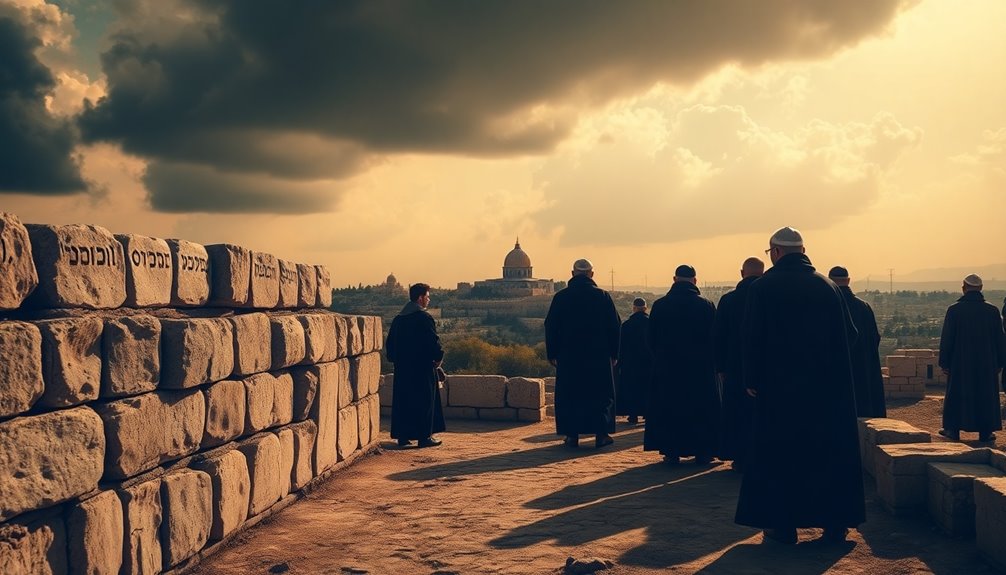You might feel that we're in the end times, especially as you see events aligning with biblical prophecies. Many interpret current natural disasters, wars, and moral decline as signs of the approaching return of Christ. The reconstitution of Israel in 1948 and advancements in technology also raise eyebrows. However, it's crucial to view these signs through the lens of hope and resilience, rather than fear. Understanding the historical context of Revelation and the expectation of first-century believers can clarify misconceptions. Explore deeper into these interpretations—there's much more to uncover about what the end times really mean.
Key Takeaways
- Many evangelicals believe current events, like natural disasters and moral decline, align with biblical prophecies about the end times.
- The reconstitution of Israel in 1948 is often viewed as a significant sign of approaching end times.
- Key biblical texts, such as Matthew 24 and Revelation, outline specific signs that may indicate the nearness of Christ's return.
- Historical context from the first century reveals that early Christians interpreted their struggles as signs of the end times.
- The rise of false teachings and societal unrest reflects prophesied spiritual decay, prompting believers to remain vigilant and faithful.
Introduction

The concept of the end times has captivated believers and skeptics alike for centuries. You may find yourself pondering how the current events of our world fit into this framework. In Christian eschatology, the end times began after Jesus' ascension, and debates about their proximity to His return continue to spark interest and concern.
Various interpretations of biblical prophecies, especially those found in the Book of Revelation, paint a complex picture. Some view these prophecies as historical, while others see them as future-oriented or a mix of both. Significant events like the reconstitution of Israel in 1948 are often cited as signs of the end times, suggesting that we're living through prophetic fulfillments.
Natural disasters, wars, and societal upheaval are commonly interpreted as signs of the end, reflecting the escalating calamities Jesus described as "birth pangs."
With over 60% of U.S. evangelicals believing in the concept of end times, you can see how prevalent this concern is within certain Christian communities. As you explore this topic, consider how these signs might suggest that Jesus will return sooner than we think.
Biblical Texts on Eschatology

When you look at the Bible, you'll find key references that shed light on eschatology, particularly in passages like Matthew 24 and Revelation.
These texts not only outline the signs of the times but also highlight the urgency of living righteously.
As we explore both primary and secondary Bible references, you'll see how they shape our understanding of the end times.
Primary Bible References
Throughout scripture, various passages provide insight into eschatology, or the study of end times. The Olivet Discourse, found in Matthew 24, Mark 13, and Luke 21, outlines significant signs such as wars, famines, and natural disasters that precede Jesus' return. These events serve as warnings, urging you to remain alert and prepared.
In Revelation 13, the rise of the Antichrist and the mark of the beast reveal a future where technological advancements enable unprecedented societal control, a concept that raises many concerns today. Additionally, 2 Timothy 3:1-5 paints a vivid picture of societal decline marked by immorality and false teachings, suggesting conditions that align with end times.
Conversely, Joel 2:28-29 prophesies an outpouring of the Holy Spirit, hinting at a spiritual revival that could occur alongside these troubling signs.
Importantly, Matthew 24:36 reminds you that no one knows the exact day or hour of Jesus' return, emphasizing the need for vigilance.
These primary biblical references guide your understanding of eschatology, highlighting the urgency of being spiritually prepared for what lies ahead.
Secondary Bible References
Numerous secondary biblical references further illuminate eschatological themes, enriching your understanding of the end times.
For instance, the Olivet Discourse, recorded in Matthew 24, Mark 13, and Luke 21, presents Jesus' teachings on the signs of the end of the age, including the destruction of the temple and various calamities that will occur before His second coming.
Revelation 13 highlights the rise of the Antichrist and introduces the mark of the beast, suggesting how technology may play a role in these end times events.
The Apostle Paul, in 2 Timothy 3:1-4, warns you about the moral decline expected in society during the last days, where selfishness and immorality will become rampant.
Conversely, the prophetic words in Joel 2:28-29 promise a spiritual outpouring, indicating a revival and increased prophetic activity among believers.
The book of Revelation serves as a reminder to stay vigilant and faithful, emphasizing that only the Father knows the exact timing of Christ's return (Mark 13:32-33).
These references collectively provide a comprehensive view of the conditions and events surrounding the end times, urging you to remain alert.
First-Century Jewish Expectations

In the first century, many Jews eagerly anticipated a messiah who'd liberate them from Roman rule and restore Israel's glory. This expectation was deeply rooted in their history, shaped by apocalyptic literature like the Book of Daniel.
First-century Jews envisioned a messianic figure who'd confront evil forces and establish God's reign on Earth, offering hope amid oppression.
The destruction of the Second Temple in 70 AD intensified these beliefs, as it was interpreted as a sign of impending divine judgment and the end times. Such events reinforced their longing for restoration and the arrival of a savior.
Jesus' teachings, particularly in the Olivet Discourse, challenged these expectations. While many envisioned a political liberator, Jesus emphasized a spiritual kingdom and the need for readiness for His return. This reframing caused a shift in understanding what it meant to await the messiah.
In this context, the Book of Revelation further elaborates on the themes of hope and divine intervention, assuring believers that despite their struggles, God's ultimate plan for restoration will prevail.
Cultural Context of Revelation

The cultural context of the Book of Revelation is crucial for understanding its message and significance. Written in the 90s AD, this text emerged during a period of severe persecution for early Christians. The historical context reveals the oppressive rule of the Roman Empire, with figures like Nero often interpreted as "the beast" due to his brutal treatment of believers. This backdrop shapes the prophetic messages within Revelation, addressing the struggles faced by its original audience.
To grasp Revelation's meaning, you need to understand the cultural nuances of first-century Judea. The significance of the temple and Jewish traditions plays a vital role in interpreting the symbolic language and imagery used throughout the text. These symbols resonated deeply with early Christians who were grappling with societal and political turmoil, providing hope amid despair.
Moreover, the diverse interpretations of Revelation often stem from differing views on its historical versus futuristic applications. Recognizing the cultural context helps clarify these variations, illustrating the importance of context in biblical exegesis.
Without this understanding, the profound messages intended for its original audience may be lost, making it essential for modern readers to engage with its cultural heritage.
Misunderstanding Revelation's Symbolism

When you read the Book of Revelation, it's easy to get caught up in popular misconceptions that twist its true meaning.
Many interpretations, especially those from sensationalist sources, miss the historical context and the core message of hope and endurance.
Let's unpack these misunderstandings to reveal what Revelation really teaches us about faith amid trials.
Debunk Common Misconceptions
Misunderstanding Revelation's symbolism often leads to misconceptions about the end times that can cause unnecessary fear and confusion. Many people fall victim to misinterpretations, thinking they can pinpoint the exact moment when Christ will return. Yet, as Mark 13:32-33 states, only the Father knows the timing, making any predictions misguided.
This is crucial to grasp, especially when you encounter sensationalized portrayals like those in the *Left Behind* series, which distort Revelation's core message.
Revelation is filled with symbolic visions meant for all generations, not simply a timeline of catastrophic events. Its true purpose is to reveal the nature of the world and offer hope rather than incite terror about the end of the end.
By recognizing that Christ's death and resurrection initiated the last days, you can better understand the context of Revelation. It's not merely about predicting doom; it's about encouraging believers to find strength and hope amid uncertainty.
Instead of fearing what's to come, focus on the message of resilience and faith that Revelation truly embodies.
Historical Accuracy of Interpretations
Throughout history, interpretations of Revelation have often strayed from its intended message, leading to widespread confusion. Many popular interpretations, like those in the "Left Behind" series, misinterpret the text by emphasizing a literal Rapture and missing the broader context of hope and redemption. This focus on apocalyptic predictions can obscure Revelation's true purpose: encouraging believers to remain steadfast in their faith during trials.
Misunderstanding Revelation often stems from an overemphasis on future events. When you believe the book exclusively pertains to what's to come, you risk neglecting its relevance for all generations since Christ's resurrection. Revelation teaches that calamities and tribulations will occur throughout history, reminding you to stay vigilant and faithful rather than getting lost in speculative end-time scenarios.
To grasp the historical accuracy of interpretations, it's crucial to recognize that Revelation's symbolic visions serve as guidance for living a faithful life today. Instead of fixating on misinterpretations, you should focus on the book's core message of hope, urging you to embody your faith amidst adversity.
Faith in Daily Decisions

Your daily choices can be a powerful reflection of your faith, especially when the world feels uncertain.
Engaging in local outreach initiatives not only strengthens your community but also demonstrates the love of Christ in action.
Daily Choices Reflect Faith
How do your daily choices reflect your faith? Every decision you make can either highlight or undermine your commitment to holiness and good deeds. As Galatians 6:10 encourages, you have the opportunity to serve others daily, embodying the good news of the gospel. Your actions in everyday life should manifest your beliefs, especially as you navigate the uncertainties of our times, as emphasized in II Peter 3:10-12.
Engaging in community and ministry work counters isolation, promoting spiritual readiness. When you actively participate in these efforts, you're not just living out your faith; you're also influencing the spiritual realms around you. Your daily choices—whether it's lending a helping hand or showing kindness—become a testimony to your beliefs.
Consistent prayer and reflection on Scripture are essential tools for guiding your decisions. By aligning your choices with God's will, you ensure your life is a reflection of His purposes, especially during these critical moments.
Local Outreach Initiatives
Local outreach initiatives play a vital role in translating faith into action, with countless opportunities available to serve your community. By engaging in acts of service like food drives, clothing donations, and supporting families in crisis, you embody the teachings of Christ. Many churches actively encourage participation in local missions, highlighting the importance of loving your neighbor and making a tangible difference.
Programs such as community gardens, tutoring for underprivileged children, and addiction recovery support showcase how your faith can influence decisions that positively impact society. When you connect with faith-based organizations that partner with local government and non-profits, you enhance outreach efforts and create a structured approach to addressing social issues.
Engaging in local outreach not only benefits the community but also fosters your spiritual growth. As you serve, you reinforce the connection between faith and action in your daily life, allowing your beliefs to manifest in meaningful ways. Additionally, participating in outreach can provide valuable insights into foster parent pay and the support systems available for those in need, enhancing your community engagement efforts.
Eschatological Implications for Today

As we navigate the complexities of today's world, it's crucial to consider the eschatological implications of our current circumstances. Many scholars agree that we're living in the end times, a period that began after Christ's ascension. The book of Revelation, penned in the 90s AD, offers significant prophetic insights that resonate with what we see unfolding now.
You might notice the signs of the times—natural disasters, moral decline, and sociopolitical unrest—these events align closely with biblical prophecies regarding the end times. The rise of false teachings and cults further reflects the spiritual decay prophesied in scripture, underscoring the importance of vigilance among believers.
Technological advancements also play a role in this eschatology. Modern commerce systems hint at the potential for a mark of the beast, indicating how contemporary developments might facilitate the fulfillment of ancient prophecies.
Additionally, the reconstitution of Israel in 1948 marks a pivotal shift in understanding end times prophecies related to that nation. All these factors compel us to reflect deeply on our faith and actions as we consider our place in these prophetic narratives.
Additional Resources

Exploring the end times can be overwhelming, but there are valuable resources available to guide you through this complex topic. One insightful book is "Preparing for Christ's Return," which helps you cultivate a mindset of readiness amidst current global uncertainties.
Similarly, "When Christ Comes: The Beginning of the Very Best" delves into the transformative implications of Christ's return for believers and the world at large.
If you're looking for a deeper understanding of biblical prophecy, "Unveiling the End Times in Our Time" offers a thorough analysis of the Book of Revelation, addressing its rich symbolism and relevance today.
For ongoing theological inquiries, the Christian Research Institute serves as an excellent resource hub, facilitating discussions around end times theology.
Additionally, platforms like Insight for Living and LeeStrobel.com provide further learning opportunities, featuring engaging content on biblical perspectives related to the end times.
If you're serious about expanding your knowledge, consider enrolling in a Bible College that offers courses focused on eschatology.
These resources will equip you to navigate the complexities of this important topic and deepen your faith as you prepare for Christ's return.
Frequently Asked Questions
What Are the Signs of the End Times?
You might notice several signs indicating significant changes.
Natural disasters like earthquakes and famines are increasing, hinting at turmoil. You see a rise in false teachings, which can mislead many.
Sociological issues like immorality and substance abuse also reflect a societal shift away from traditional values.
Additionally, technological advancements are reshaping commerce and influence.
Lastly, geopolitical events surrounding Israel's restoration are stirring global tensions, emphasizing its pivotal role in current affairs.
What Are the 7 Signs Revelations?
The seven signs in Revelation highlight significant events.
First, you'll see the opening of the seals, revealing war and famine.
Next, the trumpets sound, bringing natural disasters and plagues.
Then come the bowls of wrath, pouring out God's judgment with devastating effects.
Each sign symbolizes a part of God's complete plan, culminating in Christ's return, the establishment of His kingdom, and the ultimate judgment of humanity.
These events unfold the fullness of divine purpose.
Are We Now Living in the Last Days?
You might wonder if we're living in the last days. Many people see current events—like natural disasters, wars, and moral shifts—as signs of a significant change.
You might also notice that a growing number of believers interpret these happenings through a biblical lens, suggesting a heightened awareness of prophecy.
As you observe the world around you, consider how these perspectives shape your understanding of today's events and their potential implications for the future.
What Are the 7 Signs of the Second Coming?
You might notice several signs indicating the second coming. First, look for increased natural disasters and societal unrest.
Next, there's a rise in false teachings and moral decline. You may also observe geopolitical tensions, particularly around Israel.
Additionally, advancements in technology could hint at greater control over individuals.
Finally, consider the growing disconnection from faith and spirituality among people.
These signs, when combined, create a compelling narrative of impending change.










